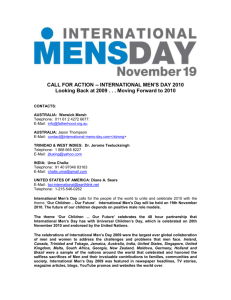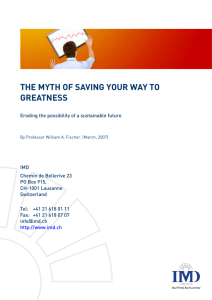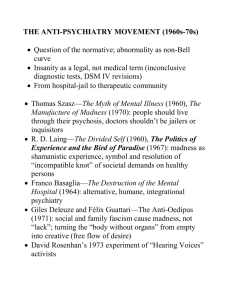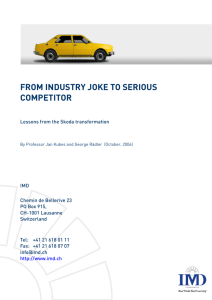from madness to mindfulness
advertisement
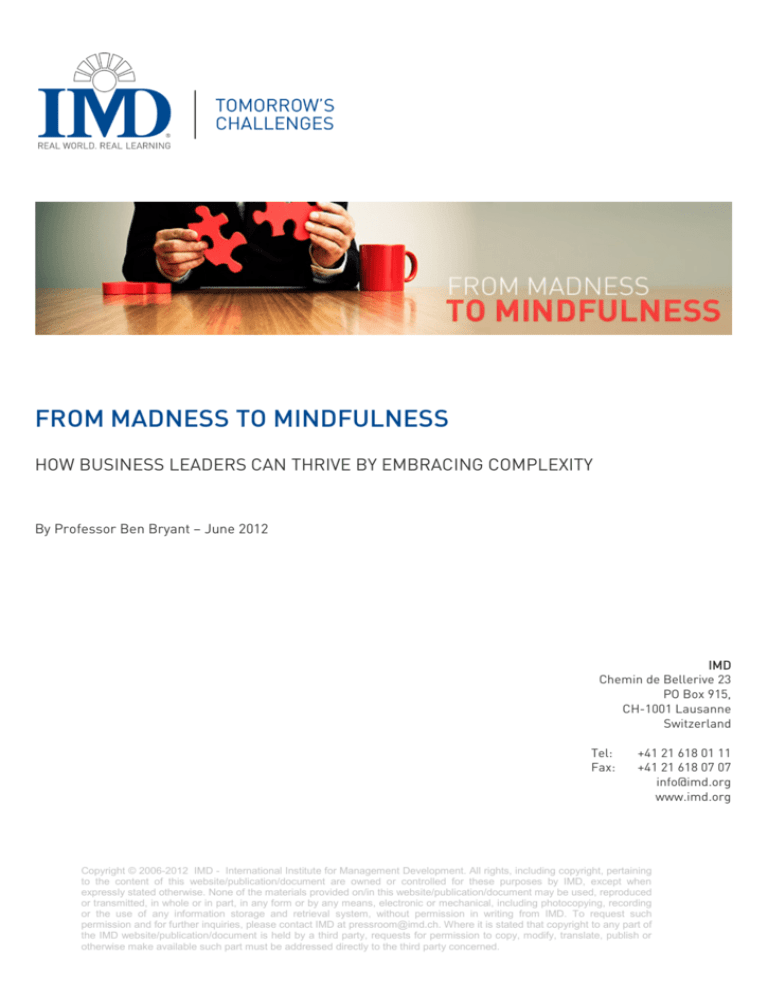
FROM MADNESS TO MINDFULNESS HOW BUSINESS LEADERS CAN THRIVE BY EMBRACING COMPLEXITY By Professor Ben Bryant – June 2012 IMD Chemin de Bellerive 23 PO Box 915, CH-1001 Lausanne Switzerland Tel: Fax: +41 21 618 01 11 +41 21 618 07 07 info@imd.org www.imd.org Copyright © 2006-2012 IMD - International Institute for Management Development. All rights, including copyright, pertaining to the content of this website/publication/document are owned or controlled for these purposes by IMD, except when expressly stated otherwise. None of the materials provided on/in this website/publication/document may be used, reproduced or transmitted, in whole or in part, in any form or by any means, electronic or mechanical, including photocopying, recording or the use of any information storage and retrieval system, without permission in writing from IMD. To request such permission and for further inquiries, please contact IMD at pressroom@imd.ch. Where it is stated that copyright to any part of the IMD website/publication/document is held by a third party, requests for permission to copy, modify, translate, publish or otherwise make available such part must be addressed directly to the third party concerned. FROM MADNESS TO MINDFULNESS I How business leaders can thrive by embracing complexity “Insanity in individuals is something rare - but in groups, parties, nations and epochs, it is the rule.” Friedrich Nietzsche Why do things get complicated as soon as we have to collaborate with other people? Business leaders across the world ask themselves this question all the time. The basic answer is that other people are unpredictable to us. They are not like us. They become anxious. And they need to protect themselves from the uncertainty of other people’s thoughts, feelings and actions (which, by the way, are usually no more unpredictable than their own behaviors toward other people). Senior executive roles lend themselves to over-defensiveness, and this often leads to irrational behavior and extra complexity in an organization – it appears to be madness at times. There is no miracle cure for this madness. The most effective option involves embracing complexity and resisting the human instinct to simplify everything. This approach is called mindfulness, and it might seem counter-intuitive at first. But mindfulness is a form of awareness and sensemaking that allows executives to make better decisions and stay in tune with others in the organization. And the good news is that it can be learnt. So how do we get from madness to mindfulness? Where does madness lie? Let’s start briefly with the madness, by highlighting four phenomena that make collective human behavior so complex. We don’t like giving up authority, power and status. Senior executives are especially reluctant to give these up even though collaboration requires them to do so. This is why so many senior teams fail to reach alignment and instead become fragmented, with different interpretations of what to do. We are all political by nature. Business leaders like forming coalitions within their organization, whether to seek power, safety or a combination of the two. There is nothing wrong with this per se. All business leaders do it – in fact, they can’t help it. But from an organizational point of view, leaders often want to protect their small coalitions at the expense of the company’s interests. We create boundaries around ourselves and the groups we work in. Boundaries give us structure and safety, both on organizational charts and in our largely unconscious norms and rules of behavior. But boundaries can also create silos that stop leaders from collaborating in an organization. Trust is elusive among senior managers. This is partly because they don’t want to hurt each other’s feelings. But it’s also because they know that by confronting each other with the truth, they face possible rejection—one of the most painful of all human feelings. Three steps to mindfulness The most common reaction to all this apparent irrationality and complexity is to put the brain on autopilot and simplify everything. The human mind automatically filters out data, uses selective perception (e.g. stereotyping) and makes us fixate on particular things so we don’t notice what is happening. Furthermore, the way the mind deals with the anxiety or frustration arising from complexity can result in uncontrollable impulses or moods. Great leaders struggle with complexity during their entire careers. But instead of simplifying reality by painting the world in black in white, they embrace complexity and keep their eyes open to shades of grey. They assess and manage highly complex variables to the best of their ability. They read situations and make sense of them. Instead of making mindless decisions, they are mindful. IMD – www.imd.org Page 2/4 FROM MADNESS TO MINDFULNESS I How business leaders can thrive by embracing complexity Step 1: Detach and Notice This first step is to detach oneself from the outside world and one’s inner thoughts. Leaders who do this are more able to recognize when they are being “hooked” or “getting stuck” in impulsive routines, and open themselves to more stimuli. They lead more effectively because they respond accurately to the context rather than reacting impulsively. They actively choose rather than automatically react on the basis of mindless (unreflective) habits and assumptions. “Noticing” means being able to take in impressions without immediately attaching meaning or judgment to them – something that is very difficult for human beings. In a business context, this means stepping back from our own agenda and watching with unblinkered eyes. In particular it means being alert to subtle signals: body language, who sits where in a meeting, and which words people choose to phrase statements. Step 2: Be in the “here and now” Humans tend to be preoccupied with plans for the future or memories of the past, and miss those factors in a situation that derive from the present moment. “Here and now” awareness contributes to mindfulness by liberating mental energy and allowing leaders to pay heed to immediate experience—as it happens. Rather than losing energy and getting bogged down in what should be, or what could have been, the best leaders learn to free their minds and focus on what is happening right now. Leaders in the “here and now” notice whether they are bored, tired, or energized. And they notice if they feel threatened or competitive, aggressive or protective towards others. Step 3: Converse The final step is to have mindful conversations and discuss what is really going on with people around you. Bringing mindfulness into the social arena in this way is difficult, because we are not used to having such conversations about complex situations. But discussing ambiguity and unpredictability and how it makes us feel can free up our mind and make it think more clearly. This is the key to overcoming complexity, and moving from madness to mindfulness. Ben Bryant is Professor of Leadership and Organization at IMD, teaches on the Orchestrating Winning Performance program, and is Director of the leadership stream on the MBA program. IMD – www.imd.org Page 3/4 FROM MADNESS TO MINDFULNESS I How business leaders can thrive by embracing complexity Related Programs ORCHESTRATING WINNING PERFORMANCE - http://www.imd.org/owp The global business program for individuals and teams Program Directors Bettina Buechel and Dominique Turpin - For individuals and teams who seek the latest management thinking and practical, innovative solutions for their business - Anticipate global business trends - Boost your performance, broaden your perspectives and expand your global network - Design the program that suits you THE IMD MBA - http://www.imd.org/mba Focus on creative leadership Program Director Martha Maznevski - A world-class MBA offering exceptional learning for exceptional individuals - Develop your future corporate leaders in this selective, cutting-edge, intense, one-year international program focused on leadership and general management - Add to your management talent by hiring experienced IMD MBA graduates ready to contribute to your business IMD – www.imd.org Page 4/4

